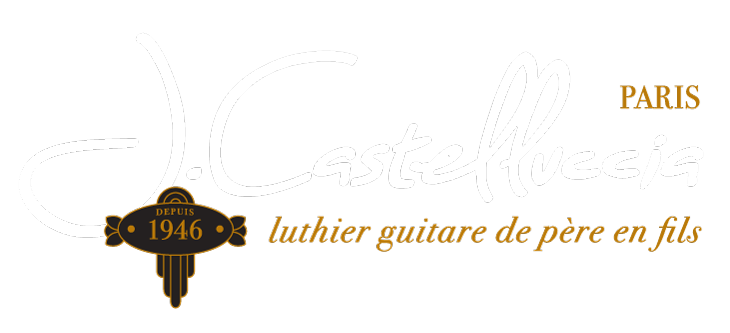The fundamentals of guitar building go through the selection of wood. Jean-Baptiste pays particular attention to the choice and the cutting of wood. Upon receipt, these timbers are sawn properly before being stored for a long drying phase (in this case, between 10 and 20 years for rosewood). The choice of the soundboard is one of the essential steps. It is experience and intuition that allow Jean-Baptiste to choose table woods. The spruce used comes from French mountain regions (western slope, 1300m altitude).
The soundboard
Initially, the soundboard is carved just like that of a violin. Jean-Baptiste fine-tunes the soundboard with a scraper in some areas, in order to adjust the thickness across the whole piece.
In the next step, the rosette is laid into the outside of the soundboard. To do this, Jean-Baptiste carves a groove to receive the marquetry of the rosette: a set of thin strips of various colors placed side by side. Once the rosette is made, it is embedded and glued into the groove.
Then comes the bracing construction phase. Each bar constituting the famous bracing is calibrated and adjusted on the soundboard. They are glued against a mold matching the curved shape of the soundboard using a particular system. With the braces glued, Jacques then proceeds to carve each one to its final profile.



When the soundboard is completed, it is ready to be glued to the sides. It is important to note that each maker has his own way of building the soundboard which determines its personality. Optimal development of the soundboard is the result of years of research.

The body
After sanding the wood for the sides to the desired thickness, he forms the contours of the instrument by slightly moistening the wood and forming it around a bending iron. Once the curve is achieved, the side is placed in a mold which holds it in the correct shape for the guitar.



Then Jean-Baptiste glues two blocks, formed to the correct shape using the mold, in the lower and upper part of the sound box. The next step is to glue in the kerfed lining on which will rest the soundboard and the back, as well as other reinforcements. Before the bottom and soundboard can be attached to the sides, Jean-Baptiste must fine-tune the shape of the sides with a plane while they are still held by the mold. He gives them the required curvature, essential to the final assembly.



The bottom braces, having been adjusted to the correct curvature of the back of the guitar, are then glued and beveled so as to allow the bottom to be glued to the lining. Once the sides, back, and soundboard are completed, Jean-Baptiste proceeds with the final assembly of the sound box.



The assembly and bonding of the body are made in two phases. The soundboard is attached first, then the back is glued in place. Once the body is assembled, any excess glue is removed. Finally, Jean-Baptiste carves a rebate around the sound box and adds the binding.


